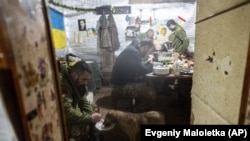On February 5, the Russian newspaper Moskovsky Komsomolets (MK.ru) claimed that Ukrainian forces had carried out major attack on the eastern Ukrainian city of Donetsk, the largest city under control by Russian-backed forces.
“Residents of Donetsk reported that the Ukrainian Armed Forces began a massive artillery shelling of the city,” MK.ru reported, citing a Telegram channel associated with Russian-aligned militias.
According to the Telegram report, Ukrainian forces used mortars, automatic grenade launchers and large-caliber artillery in the attack, from which no casualties were reported.
The reports are likely unsubstantiated.
The MK.ru article links to the Telegram post about the shelling, which included a single still photo showing what appears to be clouds of smoke on the horizon.
The photo is captioned: “The VSU [Ukrainian Armed Forces] opened artillery fire on the north of Donetsk, the airport area and Yakovlevka. There are arrivals [of flights], something is burning in the Yakovlevka area.”
It’s impossible to know from the photo alone what caused the apparent smoke.
The Organization for Security and Co-operation in Europe (OSCE) Special Monitoring Mission (SMM) report covering February 7, the day of the alleged bombardment, stated: “In Donetsk region, between the evenings of 4 and 6 February, the SMM recorded 416 ceasefire violations, including 38 explosions. In the previous reporting period, it recorded 85 ceasefire violations in the region.”
The OSCE records ceasefire violations and explosions but does not attribute them. Considering that a total of 38 explosions were reported in Donetsk region over a 48-hour period, and that it isn’t clear which side caused which explosions, it is doubtful that Ukrainian forces (or their opponents, for that matter), conducted a “massive artillery” bombardment.
The claims of a Ukrainian artillery attack targeting Donetsk come amid recent U.S. allegations that Russia, which has deployed more than 100,000 troops near Ukraine’s borders, might create a “false-flag” attack to justify a renewed invasion.
Pentagon spokesman John Kirby told reporters on February 3 that that the U.S. believed Russia was “planning to stage a fake attack by Ukrainian military or intelligence forces against Russian sovereign territory or against Russian-speaking people.” It would include, he said, “a very graphic propaganda video which would include corpses and actors that would be depicting mourners and images of destroyed locations,” along with military equipment “made to look like it was Western supplied.”
In a separate briefing, U.S. State Department spokesman Ned Price, when asked to provide evidence that Russia was planning such “false flag” attacks, said that information was classified “to protect sources and methods.”
Associated Press reporter Matt Lee challenged Price, likening U.S. claims that Russia was planning “false-flag” attacks to claims made by U.S. conspiracy theorist Alex Jones, known for labeling high-profile terrorist attacks and mass shootings as “false flags.”
Although the basis for the U.S. “false-flag” claims remains hidden, it’s been established that Russia has previously used fabricated or distorted videos and photographs for disinformation in the Donbass conflict. Donbass is the region in eastern Ukraine where the conflict began in 2014, after Russia annexed the Crimean Peninsula from Ukraine.
For example, Russian state media initially tried to pass off a photo of a mass grave taken in in Chechnya in 1995 as representing bodies of Donbass civilians allegedly killed by Ukrainian forces. In 2016, pro-Russian media claimed another photo from the Chechen War purportedly depicted a Ukrainian soldier looting geese from a farm in Donbass.
Russia has also used fabricated videos for disinformation about Donbass. In 2016, the Netherlands held a referendum on Ukraine’s entry into an association agreement with the European Union. Ahead of the vote, several videos appeared online showing masked men in military uniforms claiming to be associated with the Ukrainian National Guard’s Azov Regiment defiling Dutch flags and making threats against the Netherlands should the referendum fail. It did.
The open-source research organization Bellingcat traced these videos to the so-called Internet Research Agency in St. Petersburg. Commonly known as “the troll factory,” the IRA is widely reported to be owned by Russian businessman and Putin associate Yevgeny Prigozhin, and has also been linked to disinformation videos and campaigns targeting other countries, including the United States.
On February 7, U.S. Secretary of Defense Lloyd Austin commented on Russian disinformation about the Donbass conflict.
“We remain focused on Russian disinformation, including the potential creation of pretext for further invasion or strikes on Donbass,” a U.S. Department of Defense tweet quoted Austin as saying. “We’re seeing Russian state media spouting off now about alleged activities in Eastern Ukraine. This is straight out of the Russian playbook. They’re not fooling us.”
Russia responded to the U.S. intelligence claims with denials. In an interview with CNN, Russia's Permanent Representative to the European Union, Vladimir Chikov, claimed his country never staged "provocations."
"It's something similar to false-flag operations conducted by Western countries and certain quasi NGOs in Syria some time ago, with alleged chemical attacks allegedly by the Syrian government, but in essence by their opponents," Chikov said.
"So I can assure you that Russia is never involved in any business of this kind. And no reason, logically speaking, that that might be taking place."
Although the U.S. didn't provide its evidence for the false-flag accusations, Russia has not provided evidence for the allegedly staged chemical attacks in Syria that Chikov referenced. Polygraph.info has previously debunked such claims.





